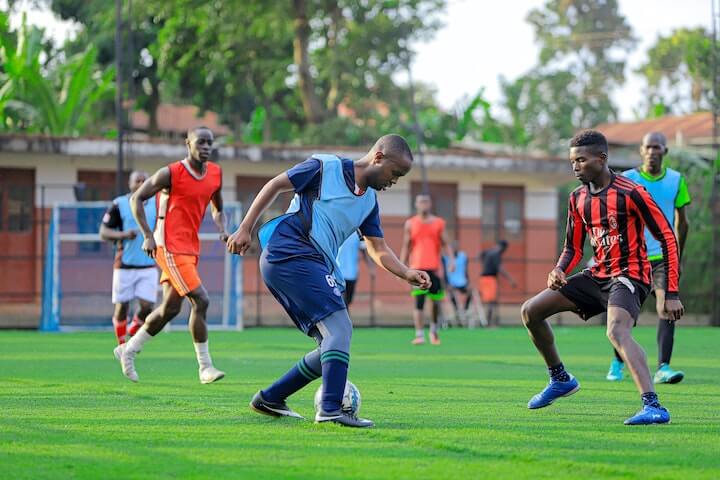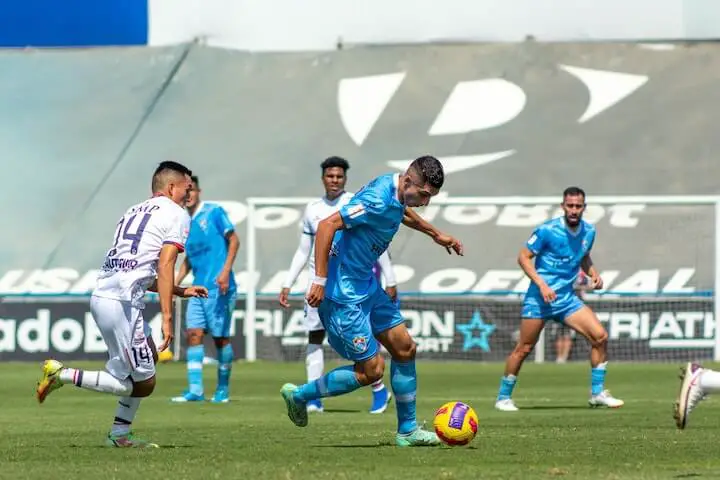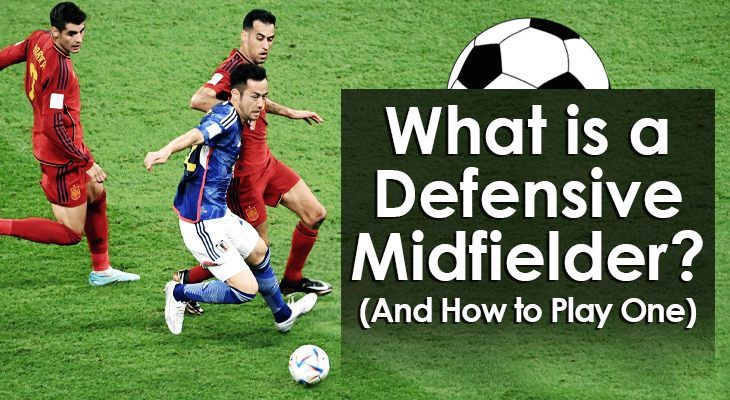What is a Defensive Midfielder? (And How to Play One)
Defensive midfielder is undoubtedly one of the most important positions of the past decade.
We've finally entered an era where this criminally undervalued role is getting the applause it deserves.
Although it’s not a flashy position, it's integral to defensive solidity and allows the more creative players to get on the ball in dangerous areas and create goalscoring chances.
In short, a defensive midfielder is the heart of the team.
They provide the aggressiveness, grit, and hard work needed to win any contest.
While this position might seem simple on paper, the defensive midfield role has many nuances that require a very specific and refined skill set.
So, what is a defensive midfielder exactly?
In this article, we break down the role and discuss the key aspects of an effective CDM (central defensive midfielder).
The 3 Defensive Midfielder Archetypes
Defensive midfielders typically play in a midfield trio, sitting between two attacking players and the defensive backline.
The CDM has a largely thankless job as they quietly go about their business, cleaning up loose balls, intercepting passes, and snuffing out opposition attacks.
Think of a defensive midfielder as a protector, shielding the backline from direct attacks, midfield overloads, and late runs into the penalty box.
Many fans -- even die-hards -- won’t notice the astute work an elite defensive midfielder goes through in every game. Their efforts are not necessarily obvious, but they’re essential.
They read the game well and ensure they’re always in the right place at the right time.
In fact, if CDMs do their job correctly, they may never be involved in a game’s “big moments”, as they effectively prevent chances or breakthroughs before anyone realizes they’re about to occur.
That said, some defensive midfielders are far more noticeable than others.
Essentially, there are three main defensive midfielder archetypes, with each one offering something slightly different from the other.

#1 - The Ball-Winner
The most traditional type of defensive midfielder is what's called an out-and-out ball-winner.
These are no-nonsense types whose primary responsibilities are to break up opposition attacks, shield the backline, and regain possession for their team.
Doing the majority of the dirty work for their teams, ball-winning central defensive midfielders are by no means flashy.
They are tenacious assassins that afford attacking players with the license to roam the field and find ways to score and assist.
While most modern teams prefer CDMs with a more comprehensive set of tools, there is still a place for ball-winning midfielders.
"Ball Winner" Examples
In terms of pure ball-winning ability, there are several specialists in today’s game, such as:
- Thomas Partey
- Kalvin Phillips
- Fernandinho
- Danilo Pereira
- Axel Witsel
However, if we want to look at some of the best to ever do it, we need to reel in the years a little and look at Claude Makélélé, Genaro Gattuso, and Daniele De Rossi.
These artists of destruction played extremely important roles off the ball and led by example on the field.
In fact, during the mid-2000s, many people referred to the defensive midfielder position as the “Makélélé role”.
During his successful tenure with Jose Mourinho’s Chelsea (2003 to 2008), the Frenchman made immense contributions to the team’s spine.
He would sit just in front of the defense and make countless tackles and interceptions. His elite conditioning and exceptional energy levels allowed him to outwork opponents from the start to the finish of every game.
While Makélélé was competent on the ball, he kept his game simple, playing predominantly short passes to the more creative players.
Gattuso and De Rossi were unapologetic brutes who exemplified the tough Italian persona that Serie A defenders were known for throughout the 90s and 00s.
While these players rarely made the headlines, their contributions were monumental.
It’s no surprise, then, that each of these central defensive midfielders enjoyed huge success throughout their careers -- on both club and international stages.
#2 - The Deep-Lying Playmaker
Not all defensive midfielders need to be hatchet men.
In modern soccer, ball retention and pressing are two of the major focuses of most teams.
A deep-lying playmaker (DLP) is the perfect antidote for playing against this type of team.
The DLP should be the most competent player in possession, ensuring the team is resistant to a high press.
They can also contribute to build-up play, receiving the ball from defenders or goalkeepers and progressing the ball from deep areas.
Defensively, a DLP isn't necessarily combative or all-action.
Instead, they use smart positional sense to intercept through balls, pick off loose passes, and mark midfielders making forward runs.
Their real value is demonstrated in possession.
A quality DLP dictates the tempo of the game, recycles possession, and even changes points of attack from within their own half.
Gifted playmakers not only beat opposition presses, but they can also thread line-breaking passes and create chances for attacking players.
"Deep-Lying Playmaker" Examples
Depending on the players available, DLPs can play in a range of formations.
However, since their primary responsibility is to progress and retain the ball, they frequently play alongside a ball-winner or two box-to-box midfielders.
Many players attempt to fulfill this role but only a small percentage truly excel.
Playing as a DLP requires the number 6 to pick up the ball in dangerous areas, with their back to goal, and several opponents close by.
Quality DLPs must be extremely skilled, aware, and calm under pressure.
One small mistake can lead to a goal against your team so margins are incredibly thin.
Some of the best DLPs in the modern game include:
- Frenkie De Jong
- Jorginho
- Toni Kroos
- Thiago Alcantara
- Rodri Hernández
Andrea Pirlo
Ask any soccer fan who comes to mind when they hear the term “deep-lying playmaker” and the vast majority will say Andrea Pirlo.
The Italian maestro won it all throughout his illustrious career for both club and country -- multiple Seria A titles, the Champions League, the World Cup, and the European Championships.
Pirlo had a magical gift of making difficult aspects of the game look like a stroll in the park.
The key to his success was undoubtedly his in-game intelligence, with a little help from his wand of a right foot.
He was rarely ever caught out of position, always available to receive a pass, and almost never turned over possession.
When afforded time and space, Pirlo’s vision and flawless technique allowed him to unlock defenses with long passes and through balls.
As a dead ball specialist, he was also a threat from corner kicks and free kicks.
Fans, pundits, and teammates marveled at Pirlo’s abilities, producing this pearl of a quote from fellow Italy and Milan hero, Genaro Gattuso:
“When I watch Pirlo play, and see him with the ball at his feet, I ask myself if I could even truly be considered a footballer at all.”
#3 - The All-Rounder
As the name suggests, an all-rounder-style defensive midfielder does a little bit of everything -- from standard defensive duties to occasionally joining attacks.
This type of CDM can play in a midfield two or three, depending on the attributes of the other players.
In a two-player midfield, the CDM will likely sit just behind a box-to-box midfielder and play in a more defensive-minded way.
In a midfield three, the CDM usually plays alongside another CDM and an attacking midfielder, or between two box-to-box midfielders.
An all-rounder-style central defensive midfielder must have a defense-oriented skill set.
However, they should also be competent on the ball and possess a good passing range.
They typically have an aggressive approach, good work ethic, and an endless gas tank.
In many cases, this type of defensive midfielder doesn’t start their career as a specialist. Rather, they adapt their solid core attributes to become competent in the role.
Other times, all-rounders are defensive specialists but possess quality in other areas of the game too. These include long-range passing, dribbling, and shooting.
All-rounder central defensive midfielders are often the most sought-after players, commanding enormous prices in the transfer market.
"All-Rounder" Examples
Many players perform the all-rounder defensive midfield role and do so quite efficiently.
However, there are a select few CDMs that stand head and shoulders above the rest.
Some of the best in the business over the past few years include:
- N’Golo Kante
- Casemiro
- Marco Veratti
- Fabinho
- Declan Rice
- Adrien Rabiot
Two of the best examples of phenomenal all-rounder-style CDMs in the modern game are N’Golo Kante and Casemiro.
While both excel at their craft, they go about the game in entirely different ways.
Let’s start with Kante.
N’Golo Kante
Often branded as a “One-Man Midfield”, Kante consistently puts in the work of multiple players and seemingly covers every blade of grass on the field.
He’s an opposition’s nightmare with his biting tackles, savvy interceptions, and general tenacity off the ball.
As one of the best ball winners of his generation, it’s easy to overlook the other attributes Kante brings to a team.
His low center of gravity ensures he moves well and is, therefore, always able to make himself available to receive the ball.
Kante possesses above-average dribbling skills for a CDM and has enough pace to run at the opposition in transition.
His complete skill set led former Chelsea Boss, Maurizio Sarri, to play him as a winger quite frequently during his tenure.
Don’t let his 5’7” slender frame fool you: N’Golo Kante is a midfield colossus.
Casemiro
Brazilian enforcer, Casemiro, is another prime example of a gifted CDM with abilities that go far beyond tackling or playmaking.
Standing 6’1”, Casemiro’s formidable stature allows him to mix it up with all comers.
While he’s not as mobile as the likes of Kante, his soccer intelligence and reading of the game ensure he’s almost always in the right place at the right time.
Aside from his 'c' , one of his greatest assets is his physical prowess in both floor and aerial challenges.
On the ball, Casemiro’s playmaking skills are first rate and he possesses vision unlike many players in his position.
Although he keeps it simple most of the time, the Brazilian occasionally threads the needle through the defense or switches the play with a precision long pass.
To boot, he has a sweet strike off his left or right foot and has quite the highlight reel of long-range screamers.
Attributes of a Defensive Midfielder
Defensive midfielders come in different shapes and sizes, with Kante and Casemiro being the perfect examples of this.
However, as a specialized position, successful CDMs must have certain key attributes.
#1 - Positional Awareness
It’s no coincidence that great defensive midfielders find themselves in the right place at the right time in each and every game.
Positional awareness is essential for disrupting attacks, tracking runs, and timing tackles.
It’s also critical for recycling possession and holding onto the ball.
Although players can learn positional awareness from good coaching, the top CDMs often have a natural instinct for where to be in and out of possession.
# - 2 Defensive Fundamentals
Defensive midfielders are heavily involved in every game.
In fact, they often get more touches than any other player.
This is mainly because they have significant offensive and defensive responsibilities.
Because they find themselves in tough situations, their fundamentals must be on point.
Otherwise they risk giving away fouls in dangerous areas or picking up yellow and red cards.
For defensive midfielders, fundamental skills include:
- Tackling
- Heading
- Marking
- Jostling
- Controlled pressuring
#3 - Work Ethic
Much of what a CDM does isn't pretty but it is extremely important.
A quality defensive midfielder is willing to put in the hard yards and go to the lengths other players aren’t willing to.
This requires having an unparalleled work ethic and determination to fight for every loose ball, 50/50 challenge, and aerial dual, regardless of the situation.
While the majority of work ethic comes down to mentality, physical fitness, or stamina, is also crucial. CDMs must ensure they are in peak condition to meet the running, physical, and mental demands of the position.
#4 - Ability to Read the Game
All high-level CDMs share a keen ability to read the game well.
Having good soccer intelligence means they can anticipate what the opposition is going to do before it happens.
This enables them to be exactly where they need to be when the time comes -- whether it's intercepting a pass, tracking a midfield runner, or getting in place to make a last-ditch block.
While having good reactions is beneficial in certain situations, the best CDMs are proactive, always putting the odds in their favor in terms of positioning and decision-making.
#5 - Communication
As the team’s anchor, the defensive midfielder must have excellent communication skills to act as a bridge between the defense and the attack.
In many instances, the CDM is the “free” player. This gives them the responsibility to instructing teammates if they're getting pressed or if another player is free.
CDMs have particularly strong ties with central defenders and other midfielders.
A lack of communication is a major contributor to turning over possession, especially when facing an aggressive press.

Conclusion
The evolution of the defensive midfielder has been a fascinating one over the past few decades.
From hard-hitting ball winners to skillful “architects”, the role has risen in prominence.
In the modern era, virtually every successful team relies on a good CDM to control the midfield and we see these players grow in their influence in big games.
As the game becomes increasingly technical, the new breed of defensive midfielder is more skilled and proficient than ever.

